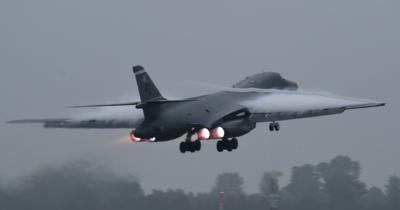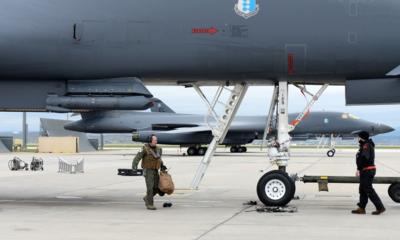'B-1 Pilots Too Fat for Ejection Seats' and Other Embarrassing Snippets Make the Rounds Online
A B-1B bomber crash from last January has been fully investigated, and the online commentariat was quick to dive into the report to see just what went wrong to cause the loss of an irreplaceable strategic bomber.

"The accident occurred during the landing sequence following a training flight with another B-1B, also stationed at Ellsworth AFB," said the USAF investigation announcement. It described the incident as a fairly understandable series of events, where a pair of aircraft conducted low-vis approaches into low-laying cloud decks. The second aircraft "attempted to land but struck the ground short of the runway and began skidding across the overrun before coming to a stop between two taxiways. The aircraft caught fire," they noted, "resulting in a complete loss of the $450 million dollar bomber."
The most popular headlines and social media posts were, unsurprisingly, taken from a snippet where investigators note that the Mishap Instructor Pilot weighed in at 260 pounds at time of post-crash hospitalization, a good deal above the maximum 211-pound weight limit of the ACES II ejection seat. The Air Force has even provided an adjusted maximum weight limit of 245 pounds for "safe and effective use", giving some extra room to those bumping against the 211-lb limit. That pilot's weight, investigators found, "likely contributed to the severity of the injuries noted from the mishap", which consisted of 'significant injuries, temporary loss of consciousness that required hospitalization.
Ex-military pilots at large scoffed in disbelief when they first heard it, remembering their own travails to 'make weight' and stay on-standard back in their service days. But this could be just another side effect of the Air Force's difficulty in retaining highly qualified pilots: The Air Force might not have the luxury of cracking down too hard if it has to worry about its best and brightest wandering off to work for the airlines at every turn, and a 260-pound pilot with 2,000 hours in the airframe is better than a 165-lb newbie with 250 hours in a 172. USAF pilots are a hot commodity, as evidenced by the Force's bonus retention schemes, and it's not the easiest thing to stay in top fighting shape.

But the weight issue helps to provide cover for what is otherwise a pretty understandable incident, where crews faced inclement weather, changing winds, and a student pilot at the helm - all things that could, if it all went well, foster excellent airmanship in the student. The crew came down into extremely low visibility for an approach, where they experienced wind shear that went from an 11-knot headwind to a 5-knot tailwind in the last 55 seconds of their descent. Ultimately, the pilot flying failed to maintain adequate control over their airspeed, going from too fast with a tailwind to too slow after dialing back the thrust, which only compounded the chain of errors as the crew up until they impacted the ground.
While it's easy to blame the pilot flying, the culpability can be spread around pretty easily: The report mentions a procedural shortcoming of nearly everyone aboard, in an aircraft that had some equipment issues, attempting an approach where the tower could hardly see the runway. The entire thing is worth a read, since it gives the distinct impression that such an approach could be had by nearly anyone at any stage of their career - all it takes is the right combination of rusty procedures, anemic CRM, and a fixation on catching sight of the runway through the mist.
 Classic Aero-TV: In Praise of Alabamas Patriot Aircraft USA
Classic Aero-TV: In Praise of Alabamas Patriot Aircraft USA NTSB Final Report: Cirrus Design Corp SR22
NTSB Final Report: Cirrus Design Corp SR22 ANN's Daily Aero-Term (12.21.25): Dead Reckoning
ANN's Daily Aero-Term (12.21.25): Dead Reckoning ANN's Daily Aero-Linx (12.21.25)
ANN's Daily Aero-Linx (12.21.25) Aero-News: Quote of the Day (12.21.25)
Aero-News: Quote of the Day (12.21.25)




